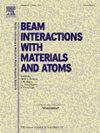Neutron depth profiling extended with PIXE element analysis
IF 1.4
3区 物理与天体物理
Q3 INSTRUMENTS & INSTRUMENTATION
Nuclear Instruments & Methods in Physics Research Section B-beam Interactions With Materials and Atoms
Pub Date : 2025-03-06
DOI:10.1016/j.nimb.2025.165672
引用次数: 0
Abstract
In a paper titled “NIXE: Neutron Depth Profiling coupled with Particle Induced X-ray Emission,” Albarqi, et al. [1] proposed a modification of the Neutron Depth Profiling (NDP) technique to use the charged particle induced X-ray (PIXE) emission generated from the energetic ions produced during nuclear reactions of the NDP process to provide additional information about the depth profile of elements near the surface of a material. This paper applies a more comprehensive analysis of the concept using the Geant4 Monte Carlo code. The results of this analysis show that the approach may be possible and produces benefits such as depth concentration for elements beyond traditional NDP. However, suppression of typical low-energy background noise is critical and would limit which NDP facilities can perform the NIXE technique. The data in this paper can inform the planning of such experiments.
中子深度剖面扩展了PIXE元素分析
在一篇题为“NIXE:中子深度剖面耦合粒子诱导x射线发射”的论文中,Albarqi等人提出了对中子深度剖面(NDP)技术的改进,利用NDP过程中核反应过程中产生的高能离子产生的带电粒子诱导x射线(PIXE)发射,提供有关材料表面附近元素深度剖面的额外信息。本文使用Geant4蒙特卡罗代码对该概念进行了更全面的分析。分析结果表明,该方法是可行的,并且可以产生诸如深度富集元素等优点,超出传统NDP的范围。然而,典型的低能量背景噪声的抑制是至关重要的,这将限制NDP设施可以执行NIXE技术。本文的数据可以为此类实验的规划提供参考。
本文章由计算机程序翻译,如有差异,请以英文原文为准。
求助全文
约1分钟内获得全文
求助全文
来源期刊
CiteScore
2.80
自引率
7.70%
发文量
231
审稿时长
1.9 months
期刊介绍:
Section B of Nuclear Instruments and Methods in Physics Research covers all aspects of the interaction of energetic beams with atoms, molecules and aggregate forms of matter. This includes ion beam analysis and ion beam modification of materials as well as basic data of importance for these studies. Topics of general interest include: atomic collisions in solids, particle channelling, all aspects of collision cascades, the modification of materials by energetic beams, ion implantation, irradiation - induced changes in materials, the physics and chemistry of beam interactions and the analysis of materials by all forms of energetic radiation. Modification by ion, laser and electron beams for the study of electronic materials, metals, ceramics, insulators, polymers and other important and new materials systems are included. Related studies, such as the application of ion beam analysis to biological, archaeological and geological samples as well as applications to solve problems in planetary science are also welcome. Energetic beams of interest include atomic and molecular ions, neutrons, positrons and muons, plasmas directed at surfaces, electron and photon beams, including laser treated surfaces and studies of solids by photon radiation from rotating anodes, synchrotrons, etc. In addition, the interaction between various forms of radiation and radiation-induced deposition processes are relevant.

 求助内容:
求助内容: 应助结果提醒方式:
应助结果提醒方式:


